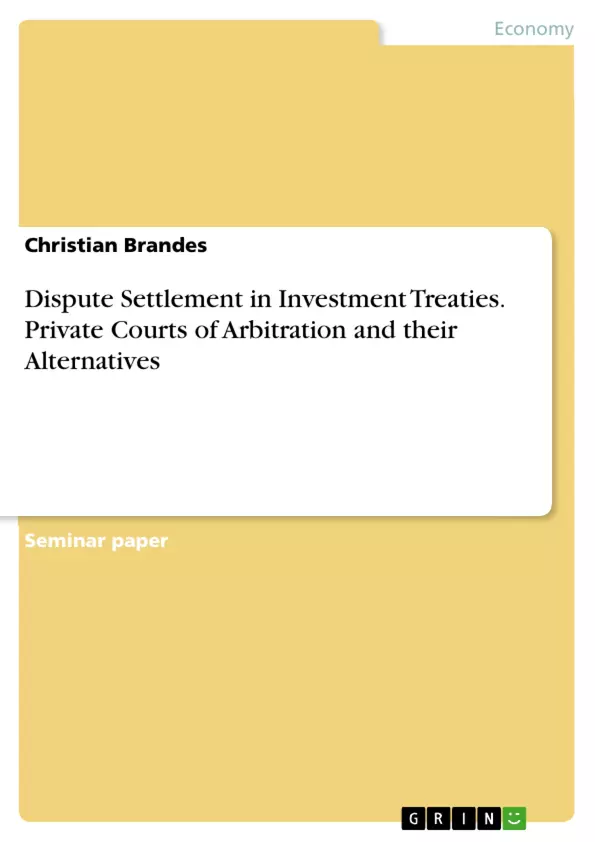In the era of Globalisation international investment flows are large. Even small and medium sized companies are active in foreign countries and economies are increasingly interdependent. Despite this globalisation process there is no unified legal framework concerning international investments and the disputes which may arise from them.
In this perspective global governance is lacking behind globalisation. International investment is one of the key drivers of economic development. Investors demand legal security, also in countries where domestic governance is weak in order to minimise the non-commercial risks. International Investment Agreements (IIA) between two or more countries serve as primary legal basis to govern and protect international investments and to settle disputes between investors and states. The framework of thousands of IIAs and within it the system of Investor State Dispute Settlement (ISDS) is fragmented and increasingly subject to harsh critique of providing inconsistent arbitration awards and lacking legitimacy in general.
This paper addresses the development of ISDS provisions in investment agreements and how the current system could be reformed.
Chapter two provides a historical overview of investment treaty practice, the roots of the current system and the development of private courts of arbitration. Main ISDS institutions and their rules will be introduced.
The following section will point out the arguments in favour and opposing ISDS. Critique will be made visible on examples of prominent cases as well as on overall findings from treaty analysis.
The final chapter deals with possibilities to reform, amend or even replace today’s ISDS regime. It will address recent megaregional agreements such like the Trans-Pacific Partnership (TPP) and the Trans-Atlantic Trade and Investment Partnership (TTIP) and their possible roles in shaping future rules which will govern international investment flows.
Inhaltsverzeichnis (Table of Contents)
- Introduction
- Development of International Investment Agreements
- The Bilateral Investment Treaty as an Instrument of Investment Protection
- International Investment after the Cold War
- Rules and Institutions of International Arbitration
- Current Arbitration Practice
- Critique of the Arbitration system
- Outcomes of ISDS Arbitration
- Reforming the International ISDS Regime
- Improving the Existing ISDS System
- Establishing an International Investment Court
- Conclusion
Zielsetzung und Themenschwerpunkte (Objectives and Key Themes)
This paper examines the development of Investor-State Dispute Settlement (ISDS) provisions in international investment agreements and explores potential reforms to the current system. The paper aims to provide a comprehensive overview of the historical evolution of ISDS, its current practice, and the ongoing debate surrounding its effectiveness and legitimacy.
- The historical development of international investment agreements and the rise of ISDS.
- The current practice of ISDS, including its strengths and weaknesses.
- The critique of ISDS, focusing on concerns regarding its consistency, legitimacy, and impact on domestic policy.
- Potential reforms to the ISDS system, including proposals for improving the existing system and establishing an international investment court.
- The role of recent megaregional agreements, such as the Trans-Pacific Partnership (TPP) and the Trans-Atlantic Trade and Investment Partnership (TTIP), in shaping future rules for international investment.
Zusammenfassung der Kapitel (Chapter Summaries)
- Introduction: This chapter introduces the topic of international investment in the context of globalization, highlighting the importance of legal security for investors and the role of international investment agreements (IIAs) in protecting and governing such investments. It also introduces the ISDS system, its fragmentation, and the increasing critique of its inconsistency and legitimacy.
- Development of International Investment Agreements: This chapter provides a historical overview of the evolution of investment treaty practice, exploring the origins of the current ISDS system. It examines the emergence of bilateral investment treaties (BITs) as a key instrument for investment protection and the development of private courts of arbitration. The chapter also introduces the major ISDS institutions and their governing rules.
- Current Arbitration Practice: This chapter delves into the current practice of ISDS, analyzing arguments both for and against the system. It examines critique of the arbitration system through prominent cases and findings from treaty analysis.
Schlüsselwörter (Keywords)
This paper focuses on international investment agreements, Investor-State Dispute Settlement (ISDS), international arbitration, bilateral investment treaties (BITs), global governance, investment protection, dispute resolution, and the reform of the ISDS regime.
- Quote paper
- Christian Brandes (Author), 2016, Dispute Settlement in Investment Treaties. Private Courts of Arbitration and their Alternatives, Munich, GRIN Verlag, https://www.grin.com/document/434210



